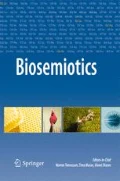Abstract
The aim of this paper is to help refine the definition of humans as “linguistic animals” in light of a comparative approach on nonhuman animals’ cognitive systems. As Uexküll & Kriszat (1934/1992) have theorized, the epistemic access to each species-specific environment (Umwelt) is driven by different biocognitive processes. Within this conceptual framework, I identify the salient cognitive process that distinguishes each species typical perception of the world as the faculty of language meant in the following operational definition: the ability to connect different elements according to structural rules. In order to draw some conclusions about humans’ specific faculty of language, I review different empirical studies on nonhuman animals’ ability to recognize formal patterns of tokens. I suggest that what differentiates human language from other animals’ cognitive systems is the ability to categorize the units of a pattern, going beyond its perceptual aspects. In fact, humans are the only species known to be able to combine semantic units within a network of combinatorial logical relationships (Deacon 1997) that can be linked to the state of affairs in the external world (Wittgenstein 1922). I assume that this ability is the core cognitive process underlying a) the capacity to speak (or to reason) in verbal propositions and b) the general human faculty of language expressed, for instance, in the ability to draw visual conceptual maps or to compute mathematical expressions. In light of these considerations, I conclude providing some research questions that could lead to a more detailed comparative exploration of the faculty of language.



Similar content being viewed by others
Notes
Hereafter I will italicize the terms “syntax” and “syntactic” when used according to this specified etymological sense.
Here the term “object” is used in a broad sense, referring to abstract or concrete entities, as well as to actions, subjects, etc.
The logical connections are those expressed both through morpho-syntactic links and logical connectors.
References
Abe, K., & Watanabe, D. (2011). Songbirds possess the spontaneous ability to discriminate syntactic rules. Nature Neuroscience, 14(2011), 1067–74.
Aristotle (2004). Metaphysics. (H. Lawson-Tancred, Trans.) England: Penguin Classics. (Original work ≈ 350 b.C.).
Berwick, R. C., Okanoya, K., Beckers, G. J. L., & Bolhuis, J. (2011). Songs to syntax: the linguistics of birdsong. Trends in Cognitive Science, 159, 113–21.
Carapezza, M. (2006). Uexküll, la nozione di Umwelt e il parlare di animali. Annali del dipartimento di Filosofia, Storia e Critica dei Saperi, Università di Palermo, 47–60.
Christiansen, M. H., & Chater, N. (1999). Toward a connectionist model of recursion in human linguistic performance. Cognitive Science, 23, 157–205.
Chomsky, N., Three models for the description of language, Information Theory, 1956.
Chomsky, N. (1965). Aspects of the theory of syntax. Cambridge: MIT.
Corballis, M. C. (2007). Recursion, language, and starlings. Cognitive Science, 31, 697–704.
Deacon, T. W. (1997). The symbolic species. The coevolution of language and the brain. New York: Norton & Company.
Fitch, W. T., & Hauser, M. D. (2004). Computational constraints on syntactic processing in a nonhuman primate. Science, 303, 377–80.
Fitch, W. T. (2010). Three meanings of “recursion”: key distinctions for biolinguistics. In R. K. Larson, V. Deprez, & H. Yamakido (Eds.), The evolution of human language: biolinguistic perspectives (pp. 73–90). New York: Cambridge University Press.
Fitch, W. T., & Friederici, A. D. (2012). Artificial grammar learning meets formal language theory: an overview. Philosophical Transactions of the Royal Society, 367, 1933–1955.
Fitch, W. T., Friederici, A. D., & Hagoort, P. (2012). Pattern Perception and computational complexity: an introduction to the special issue. Philosophical Transactions of the Royal Society, 367, 1925–1932.
Gentner, T. Q., Fenn, K. M., Margoliash, D., & Nusbaum, H. C. (2006). Recursive syntactic pattern learning by songbirds. Nature, 440, 1204–207.
Hauser, M. D., Fitch, W. T., & Chomsky, N. (2002). The faculty of language: what is it, who has it, and how did it evolve? Science, 298, 1569–79.
Lo Piparo, F. (1998). Il mondo, le specie animali e il linguaggio. La teoria zoocognitiva di Wittgenstein. In M. Carenini & M. Matteuzzi (Eds.), Percezione, Linguaggio, Coscienza. Saggi di filosofia della mente (pp. 183–202). Macerata: Quodlibet.
O’Donnell, T. J., Hauser, M. D., & Fitch, W. T. (2005). Using mathematical models of language experimentally. Trends in Cognitive Sciences, 9, 284–89.
Okanoya, K. (2004). Song syntax in Bengalese Finches: proximate and ultimate analyses. Advances in the Study of Behavior, 14, 297–346.
Uexküll, J. von e G. Kriszat (1992). A stroll through the worlds of animals and men: A picture book of invisible worlds. Semiotica, 89(4). doi:10.1515/semi.1992.89.4.319.
Van Heijningen, C. A., De Visser, J., Zuidema, W., & Ten Cate, C. (2009). Simple rules can explain discrimination of putative recursive syntactic structures by a songbird species. Proceedings of the National Academy of Sciences, 106(48), 20538–43.
Wittgenstein, L. (1922). Tractatus logico-philosophicus. (F. P. Ogden & C. K. Ramsey, Trans.). Oxford, England: Routledge and Kegan Paul. (Original work published 1921).
Acknowledgments
I thank Marco Carapezza, Franco Lo Piparo and W. Tecumseh Fitch for their invaluable help in thinking through the concepts explained in the manuscript, and for encouraging my research. Funding was provided by the University of Palermo and by a European Research Council Advanced Grant SOMACCA (No. 230604) awarded to W. T. Fitch. The funders had no role in the decision to publish or prepare the manuscript.
Author information
Authors and Affiliations
Corresponding author
Rights and permissions
About this article
Cite this article
Filippi, P. Specifically Human: Going Beyond Perceptual Syntax. Biosemiotics 7, 111–123 (2014). https://doi.org/10.1007/s12304-013-9187-3
Received:
Accepted:
Published:
Issue Date:
DOI: https://doi.org/10.1007/s12304-013-9187-3



